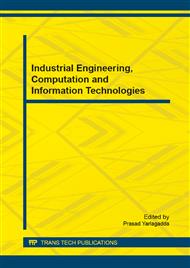[1]
Collins, R.T., Gross, R., Shi, J.: Silhouette-based Human Identification from Body Shape and Gait. In: Fifth IEEE International Conference on May 21-21, p.366–371 (2002).
DOI: 10.1109/afgr.2002.1004181
Google Scholar
[2]
Nixon, M.S., Carter, J.N. (2006). Automatic recognition by gait. In Proceedings of IEEE, 94(11), 2013–(2024).
Google Scholar
[3]
Niyogi, S., & Adelson, E. (1994). Analyzing and recognizing walking figures in XYT. In Proceedings of CVPR'94 (p.469–474).
DOI: 10.1109/cvpr.1994.323868
Google Scholar
[4]
Li, X.L., Maybank, S.J., Yan, S.J., Tao, D.C., & Xu, D.J. (2008). Gait components and their application to gender recognition. IEEE Trans. SMC-C, 38(2), 145–155.
DOI: 10.1109/tsmcc.2007.913886
Google Scholar
[5]
Wang, L. (2006). Abnormal walking gait analysis using silhouette-masked flow histograms. In Proceedings of ICPR'06: Vol. 3 (p.473–476).
DOI: 10.1109/icpr.2006.199
Google Scholar
[6]
Zhou, X.L., & Bhanu, B. (2007). Integrating face and gait for human recognition at a distance in video. IEEE Trans. SMC-B, 37(5), 1119–1137.
DOI: 10.1109/tsmcb.2006.889612
Google Scholar
[7]
Jafri, R., & Arabnia, H.R. (2008). Fusion of face and gait for automatic human recognition. In Proc. of the Fifth International Conference on Information Technology.
DOI: 10.1109/itng.2008.33
Google Scholar
[8]
Kale A, Sundaresan A, Rajagopalan A N, et al. Identification of human using gait. IEEE Transaction on Image Processing, vol. 13, no. 9, pp.1163-1173, (2004).
DOI: 10.1109/tip.2004.832865
Google Scholar
[9]
Han Su, Fenggang Huang, A novel gait recognition method using periodic sequence width image, Journal of Image and Graphics, vol. 8, pp.1383-1388, (2007).
Google Scholar
[10]
Han, J., Bir, B.: Statistical Feature Fusion for Gait-based Human Recognition. In: Proc. Of the 2004 IEEE Computer Society Conference on Computer Vision and Pattern Recognition, pp. II842–II847 (2004).
DOI: 10.1109/cvpr.2004.1315252
Google Scholar
[11]
Han Su, Zhi-Wu Liao, Guo-Yue Chen. A Gait Recognition Method Using L1-PCA and LDA. Proceedings of the Eighth International Conference on Machine Learning and Cybernetics, Baoding, 2009: 3198-3203.
DOI: 10.1109/icmlc.2009.5212776
Google Scholar
[12]
Hong, Lang, Multiresolutional Estimation Using Wavelet Transform., IEEE Trans. On Aerospace and Electronic Systems, Vol. 29, No. 4, (1993).
Google Scholar
[13]
Jihoon Y, Vasant H. Feature subset selection using a genetic algorithm. IEEE Intelligent System Special Issue: Feature Transformation Subset Selection, 1998, 44-49.
DOI: 10.1109/5254.671091
Google Scholar
[14]
Bir Bhanu, Yingqiang Lin. Genetic algorithm based feature selection for target detection in SAR images. Image and Vision Computing 21 (2003) 591–608.
DOI: 10.1016/s0262-8856(03)00057-x
Google Scholar
[15]
Sarkar, S., Phillips, P., Liu, Z., Vega, I., Grother, P., Bowyer, K., 2005. The humanID gait challenge problem: Data sets, performance, and analysis. IEEE Trans. PAMI 27 (2), 62–177.
DOI: 10.1109/tpami.2005.39
Google Scholar


